Management Competencies: A Reflective Analysis Report
VerifiedAdded on 2023/03/29
|8
|1347
|419
Report
AI Summary
This report provides a comprehensive reflection on management competencies using the Competing Values Framework (CVF). Part A compares the initial and current CVF results, focusing on the collaborate, create, compete, and control quadrants and associated roles. It highlights improvements in various roles such as mentor, facilitator, innovator, director, producer, coordinator, and monitor. The analysis identifies the compete quadrant as the area of greatest competency, followed by collaborate, control, and create. Part B discusses the impact of the internal environment on tourism and hospitality management, referencing Community Blog 1. It identifies competing values, paradoxical views, and complementary models, emphasizing the importance of flexibility and adaptability for managers in attracting customers and driving organizational success. The report concludes with a reflection on the importance of motivation, communication, and cohesion in achieving management mastery.

CVF 1
CVF
By (Student’s Name)
Professor’s Name
College
Course
Date
CVF
By (Student’s Name)
Professor’s Name
College
Course
Date
Paraphrase This Document
Need a fresh take? Get an instant paraphrase of this document with our AI Paraphraser
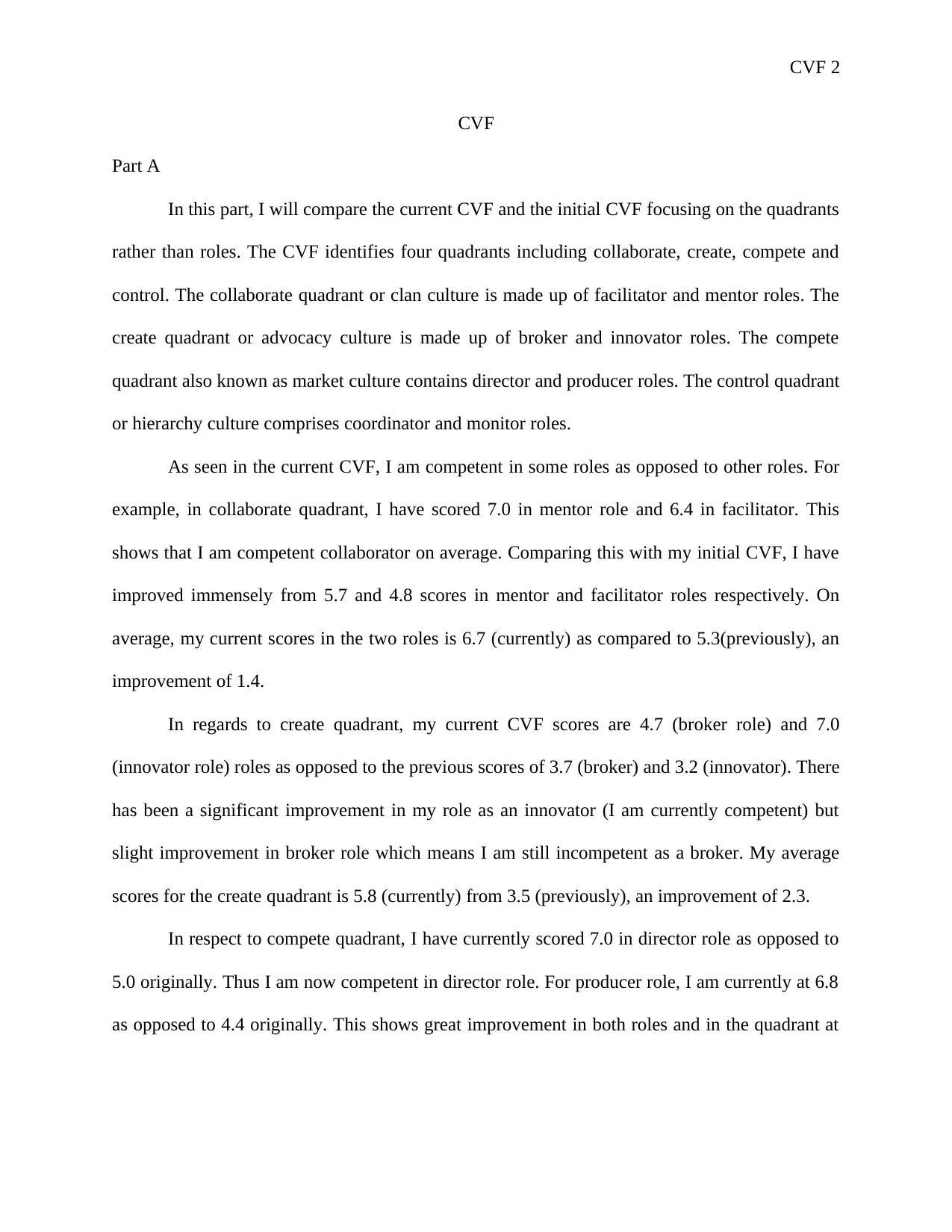
CVF 2
CVF
Part A
In this part, I will compare the current CVF and the initial CVF focusing on the quadrants
rather than roles. The CVF identifies four quadrants including collaborate, create, compete and
control. The collaborate quadrant or clan culture is made up of facilitator and mentor roles. The
create quadrant or advocacy culture is made up of broker and innovator roles. The compete
quadrant also known as market culture contains director and producer roles. The control quadrant
or hierarchy culture comprises coordinator and monitor roles.
As seen in the current CVF, I am competent in some roles as opposed to other roles. For
example, in collaborate quadrant, I have scored 7.0 in mentor role and 6.4 in facilitator. This
shows that I am competent collaborator on average. Comparing this with my initial CVF, I have
improved immensely from 5.7 and 4.8 scores in mentor and facilitator roles respectively. On
average, my current scores in the two roles is 6.7 (currently) as compared to 5.3(previously), an
improvement of 1.4.
In regards to create quadrant, my current CVF scores are 4.7 (broker role) and 7.0
(innovator role) roles as opposed to the previous scores of 3.7 (broker) and 3.2 (innovator). There
has been a significant improvement in my role as an innovator (I am currently competent) but
slight improvement in broker role which means I am still incompetent as a broker. My average
scores for the create quadrant is 5.8 (currently) from 3.5 (previously), an improvement of 2.3.
In respect to compete quadrant, I have currently scored 7.0 in director role as opposed to
5.0 originally. Thus I am now competent in director role. For producer role, I am currently at 6.8
as opposed to 4.4 originally. This shows great improvement in both roles and in the quadrant at
CVF
Part A
In this part, I will compare the current CVF and the initial CVF focusing on the quadrants
rather than roles. The CVF identifies four quadrants including collaborate, create, compete and
control. The collaborate quadrant or clan culture is made up of facilitator and mentor roles. The
create quadrant or advocacy culture is made up of broker and innovator roles. The compete
quadrant also known as market culture contains director and producer roles. The control quadrant
or hierarchy culture comprises coordinator and monitor roles.
As seen in the current CVF, I am competent in some roles as opposed to other roles. For
example, in collaborate quadrant, I have scored 7.0 in mentor role and 6.4 in facilitator. This
shows that I am competent collaborator on average. Comparing this with my initial CVF, I have
improved immensely from 5.7 and 4.8 scores in mentor and facilitator roles respectively. On
average, my current scores in the two roles is 6.7 (currently) as compared to 5.3(previously), an
improvement of 1.4.
In regards to create quadrant, my current CVF scores are 4.7 (broker role) and 7.0
(innovator role) roles as opposed to the previous scores of 3.7 (broker) and 3.2 (innovator). There
has been a significant improvement in my role as an innovator (I am currently competent) but
slight improvement in broker role which means I am still incompetent as a broker. My average
scores for the create quadrant is 5.8 (currently) from 3.5 (previously), an improvement of 2.3.
In respect to compete quadrant, I have currently scored 7.0 in director role as opposed to
5.0 originally. Thus I am now competent in director role. For producer role, I am currently at 6.8
as opposed to 4.4 originally. This shows great improvement in both roles and in the quadrant at
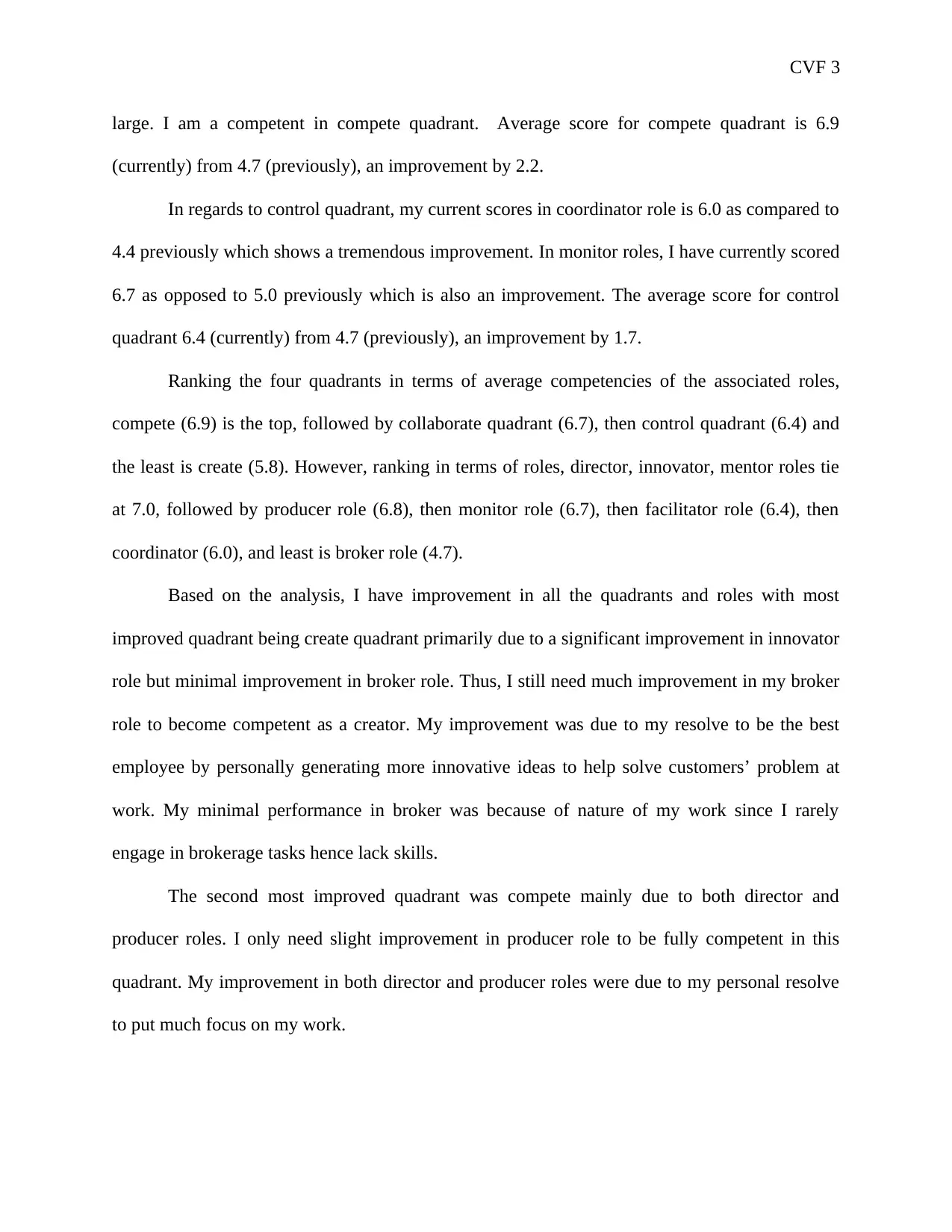
CVF 3
large. I am a competent in compete quadrant. Average score for compete quadrant is 6.9
(currently) from 4.7 (previously), an improvement by 2.2.
In regards to control quadrant, my current scores in coordinator role is 6.0 as compared to
4.4 previously which shows a tremendous improvement. In monitor roles, I have currently scored
6.7 as opposed to 5.0 previously which is also an improvement. The average score for control
quadrant 6.4 (currently) from 4.7 (previously), an improvement by 1.7.
Ranking the four quadrants in terms of average competencies of the associated roles,
compete (6.9) is the top, followed by collaborate quadrant (6.7), then control quadrant (6.4) and
the least is create (5.8). However, ranking in terms of roles, director, innovator, mentor roles tie
at 7.0, followed by producer role (6.8), then monitor role (6.7), then facilitator role (6.4), then
coordinator (6.0), and least is broker role (4.7).
Based on the analysis, I have improvement in all the quadrants and roles with most
improved quadrant being create quadrant primarily due to a significant improvement in innovator
role but minimal improvement in broker role. Thus, I still need much improvement in my broker
role to become competent as a creator. My improvement was due to my resolve to be the best
employee by personally generating more innovative ideas to help solve customers’ problem at
work. My minimal performance in broker was because of nature of my work since I rarely
engage in brokerage tasks hence lack skills.
The second most improved quadrant was compete mainly due to both director and
producer roles. I only need slight improvement in producer role to be fully competent in this
quadrant. My improvement in both director and producer roles were due to my personal resolve
to put much focus on my work.
large. I am a competent in compete quadrant. Average score for compete quadrant is 6.9
(currently) from 4.7 (previously), an improvement by 2.2.
In regards to control quadrant, my current scores in coordinator role is 6.0 as compared to
4.4 previously which shows a tremendous improvement. In monitor roles, I have currently scored
6.7 as opposed to 5.0 previously which is also an improvement. The average score for control
quadrant 6.4 (currently) from 4.7 (previously), an improvement by 1.7.
Ranking the four quadrants in terms of average competencies of the associated roles,
compete (6.9) is the top, followed by collaborate quadrant (6.7), then control quadrant (6.4) and
the least is create (5.8). However, ranking in terms of roles, director, innovator, mentor roles tie
at 7.0, followed by producer role (6.8), then monitor role (6.7), then facilitator role (6.4), then
coordinator (6.0), and least is broker role (4.7).
Based on the analysis, I have improvement in all the quadrants and roles with most
improved quadrant being create quadrant primarily due to a significant improvement in innovator
role but minimal improvement in broker role. Thus, I still need much improvement in my broker
role to become competent as a creator. My improvement was due to my resolve to be the best
employee by personally generating more innovative ideas to help solve customers’ problem at
work. My minimal performance in broker was because of nature of my work since I rarely
engage in brokerage tasks hence lack skills.
The second most improved quadrant was compete mainly due to both director and
producer roles. I only need slight improvement in producer role to be fully competent in this
quadrant. My improvement in both director and producer roles were due to my personal resolve
to put much focus on my work.
⊘ This is a preview!⊘
Do you want full access?
Subscribe today to unlock all pages.

Trusted by 1+ million students worldwide
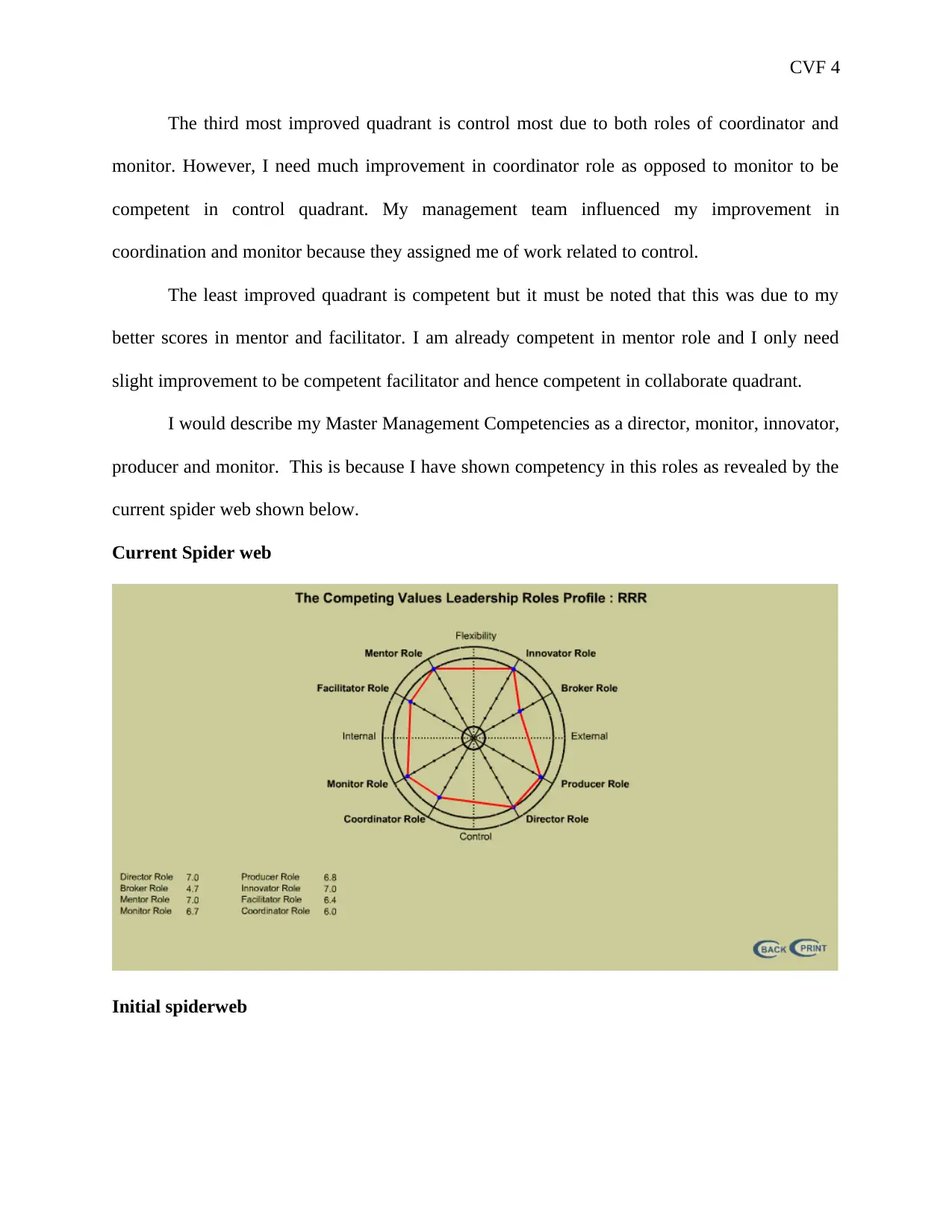
CVF 4
The third most improved quadrant is control most due to both roles of coordinator and
monitor. However, I need much improvement in coordinator role as opposed to monitor to be
competent in control quadrant. My management team influenced my improvement in
coordination and monitor because they assigned me of work related to control.
The least improved quadrant is competent but it must be noted that this was due to my
better scores in mentor and facilitator. I am already competent in mentor role and I only need
slight improvement to be competent facilitator and hence competent in collaborate quadrant.
I would describe my Master Management Competencies as a director, monitor, innovator,
producer and monitor. This is because I have shown competency in this roles as revealed by the
current spider web shown below.
Current Spider web
Initial spiderweb
The third most improved quadrant is control most due to both roles of coordinator and
monitor. However, I need much improvement in coordinator role as opposed to monitor to be
competent in control quadrant. My management team influenced my improvement in
coordination and monitor because they assigned me of work related to control.
The least improved quadrant is competent but it must be noted that this was due to my
better scores in mentor and facilitator. I am already competent in mentor role and I only need
slight improvement to be competent facilitator and hence competent in collaborate quadrant.
I would describe my Master Management Competencies as a director, monitor, innovator,
producer and monitor. This is because I have shown competency in this roles as revealed by the
current spider web shown below.
Current Spider web
Initial spiderweb
Paraphrase This Document
Need a fresh take? Get an instant paraphrase of this document with our AI Paraphraser
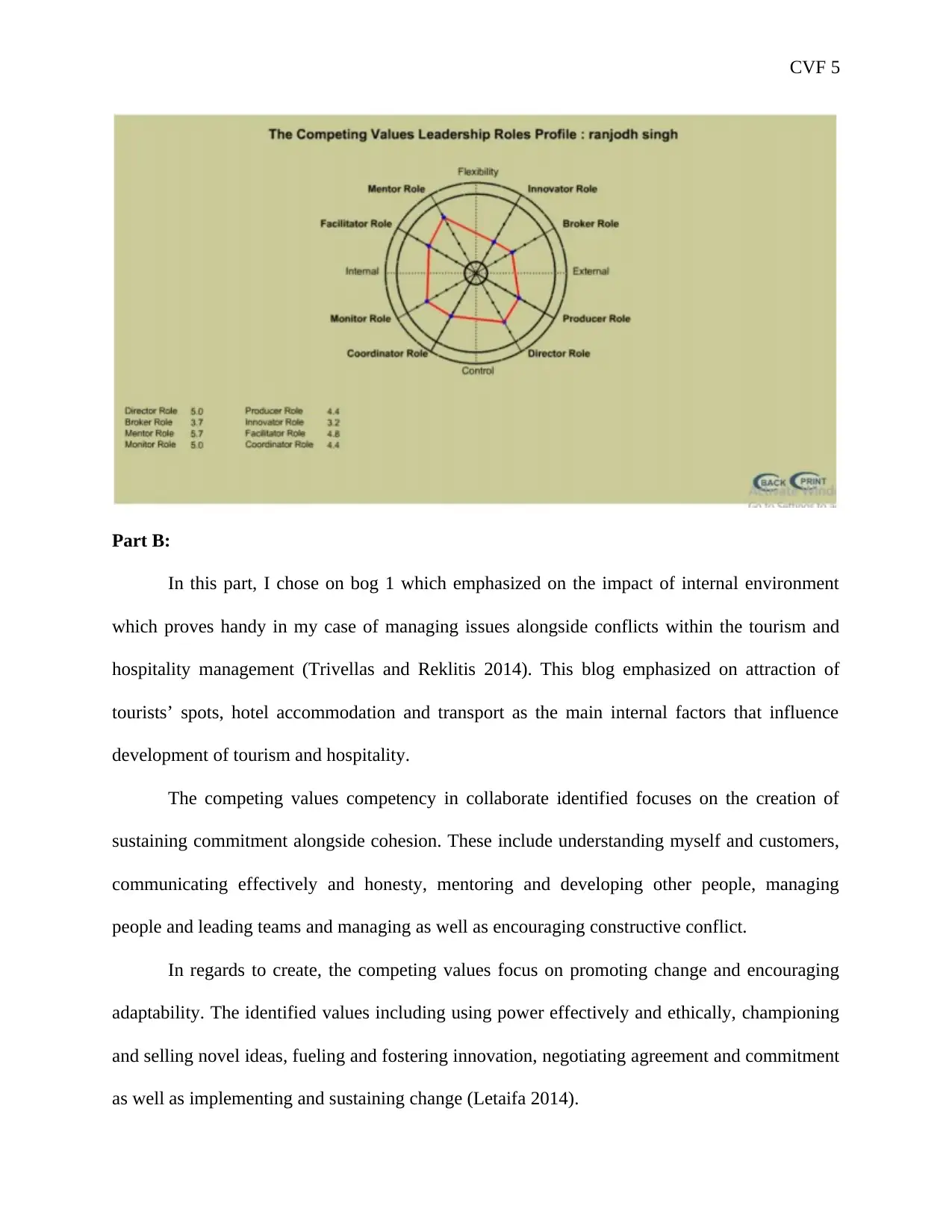
CVF 5
Part B:
In this part, I chose on bog 1 which emphasized on the impact of internal environment
which proves handy in my case of managing issues alongside conflicts within the tourism and
hospitality management (Trivellas and Reklitis 2014). This blog emphasized on attraction of
tourists’ spots, hotel accommodation and transport as the main internal factors that influence
development of tourism and hospitality.
The competing values competency in collaborate identified focuses on the creation of
sustaining commitment alongside cohesion. These include understanding myself and customers,
communicating effectively and honesty, mentoring and developing other people, managing
people and leading teams and managing as well as encouraging constructive conflict.
In regards to create, the competing values focus on promoting change and encouraging
adaptability. The identified values including using power effectively and ethically, championing
and selling novel ideas, fueling and fostering innovation, negotiating agreement and commitment
as well as implementing and sustaining change (Letaifa 2014).
Part B:
In this part, I chose on bog 1 which emphasized on the impact of internal environment
which proves handy in my case of managing issues alongside conflicts within the tourism and
hospitality management (Trivellas and Reklitis 2014). This blog emphasized on attraction of
tourists’ spots, hotel accommodation and transport as the main internal factors that influence
development of tourism and hospitality.
The competing values competency in collaborate identified focuses on the creation of
sustaining commitment alongside cohesion. These include understanding myself and customers,
communicating effectively and honesty, mentoring and developing other people, managing
people and leading teams and managing as well as encouraging constructive conflict.
In regards to create, the competing values focus on promoting change and encouraging
adaptability. The identified values including using power effectively and ethically, championing
and selling novel ideas, fueling and fostering innovation, negotiating agreement and commitment
as well as implementing and sustaining change (Letaifa 2014).
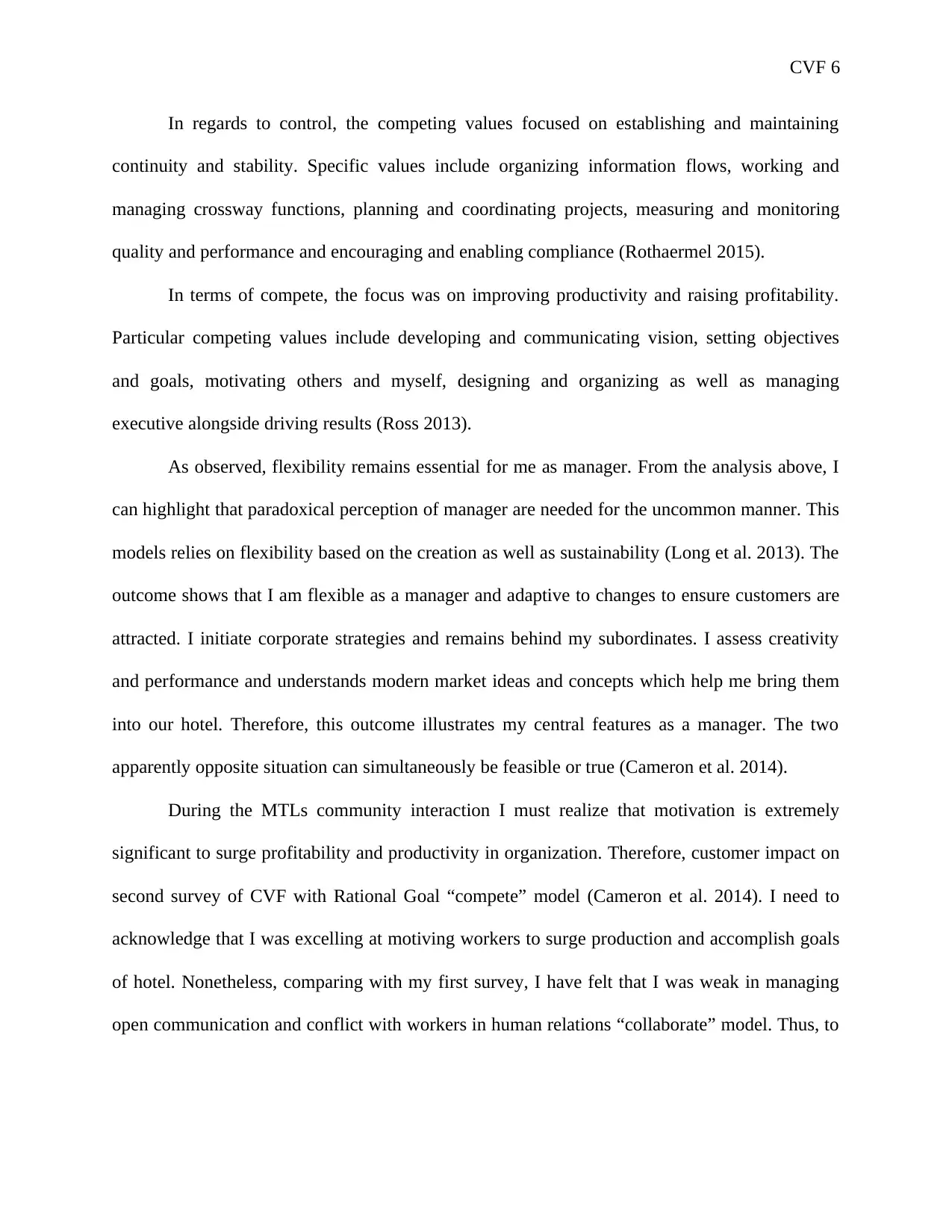
CVF 6
In regards to control, the competing values focused on establishing and maintaining
continuity and stability. Specific values include organizing information flows, working and
managing crossway functions, planning and coordinating projects, measuring and monitoring
quality and performance and encouraging and enabling compliance (Rothaermel 2015).
In terms of compete, the focus was on improving productivity and raising profitability.
Particular competing values include developing and communicating vision, setting objectives
and goals, motivating others and myself, designing and organizing as well as managing
executive alongside driving results (Ross 2013).
As observed, flexibility remains essential for me as manager. From the analysis above, I
can highlight that paradoxical perception of manager are needed for the uncommon manner. This
models relies on flexibility based on the creation as well as sustainability (Long et al. 2013). The
outcome shows that I am flexible as a manager and adaptive to changes to ensure customers are
attracted. I initiate corporate strategies and remains behind my subordinates. I assess creativity
and performance and understands modern market ideas and concepts which help me bring them
into our hotel. Therefore, this outcome illustrates my central features as a manager. The two
apparently opposite situation can simultaneously be feasible or true (Cameron et al. 2014).
During the MTLs community interaction I must realize that motivation is extremely
significant to surge profitability and productivity in organization. Therefore, customer impact on
second survey of CVF with Rational Goal “compete” model (Cameron et al. 2014). I need to
acknowledge that I was excelling at motiving workers to surge production and accomplish goals
of hotel. Nonetheless, comparing with my first survey, I have felt that I was weak in managing
open communication and conflict with workers in human relations “collaborate” model. Thus, to
In regards to control, the competing values focused on establishing and maintaining
continuity and stability. Specific values include organizing information flows, working and
managing crossway functions, planning and coordinating projects, measuring and monitoring
quality and performance and encouraging and enabling compliance (Rothaermel 2015).
In terms of compete, the focus was on improving productivity and raising profitability.
Particular competing values include developing and communicating vision, setting objectives
and goals, motivating others and myself, designing and organizing as well as managing
executive alongside driving results (Ross 2013).
As observed, flexibility remains essential for me as manager. From the analysis above, I
can highlight that paradoxical perception of manager are needed for the uncommon manner. This
models relies on flexibility based on the creation as well as sustainability (Long et al. 2013). The
outcome shows that I am flexible as a manager and adaptive to changes to ensure customers are
attracted. I initiate corporate strategies and remains behind my subordinates. I assess creativity
and performance and understands modern market ideas and concepts which help me bring them
into our hotel. Therefore, this outcome illustrates my central features as a manager. The two
apparently opposite situation can simultaneously be feasible or true (Cameron et al. 2014).
During the MTLs community interaction I must realize that motivation is extremely
significant to surge profitability and productivity in organization. Therefore, customer impact on
second survey of CVF with Rational Goal “compete” model (Cameron et al. 2014). I need to
acknowledge that I was excelling at motiving workers to surge production and accomplish goals
of hotel. Nonetheless, comparing with my first survey, I have felt that I was weak in managing
open communication and conflict with workers in human relations “collaborate” model. Thus, to
⊘ This is a preview!⊘
Do you want full access?
Subscribe today to unlock all pages.

Trusted by 1+ million students worldwide

CVF 7
become master manager, I need skills to focus on creation and staying committed and cohesive
in our organization.
become master manager, I need skills to focus on creation and staying committed and cohesive
in our organization.
Paraphrase This Document
Need a fresh take? Get an instant paraphrase of this document with our AI Paraphraser

CVF 8
References
Cameron, K.S., Quinn, R.E., DeGraff, J. and Thakor, A.V., 2014. Competing values leadership.
Edward Elgar Publishing.
Knight, W.A., 2016. Distinguishing and unifying visionary Leadership and Mechanical
Management1. The Ashgate Research Companion to Political Leadership, p.135.
Letaifa, S.B., 2014. The Uneasy transition from supply chains to ecosystems: the value-
creation/value-capture dilemma. Management Decision, 52(2), pp.278-295.
Long, C.S., Wan Ismail, W.K. and Amin, S.M., 2013. The role of change agent as mediator in
the relationship between HR competencies and organizational performance. The International
Journal of Human Resource Management, 24(10), pp.2019-2033.
Ross, D.F., 2013. Competing through supply chain management: creating market-winning
strategies through supply chain partnerships. Springer Science & Business Media.
Rothaermel, F.T., 2015. Strategic management. McGraw-Hill.
Trivellas, P. and Reklitis, P., 2014. Leadership competencies profiles and managerial
effectiveness in Greece. Procedia Economics and Finance, 9, pp.380-390.
References
Cameron, K.S., Quinn, R.E., DeGraff, J. and Thakor, A.V., 2014. Competing values leadership.
Edward Elgar Publishing.
Knight, W.A., 2016. Distinguishing and unifying visionary Leadership and Mechanical
Management1. The Ashgate Research Companion to Political Leadership, p.135.
Letaifa, S.B., 2014. The Uneasy transition from supply chains to ecosystems: the value-
creation/value-capture dilemma. Management Decision, 52(2), pp.278-295.
Long, C.S., Wan Ismail, W.K. and Amin, S.M., 2013. The role of change agent as mediator in
the relationship between HR competencies and organizational performance. The International
Journal of Human Resource Management, 24(10), pp.2019-2033.
Ross, D.F., 2013. Competing through supply chain management: creating market-winning
strategies through supply chain partnerships. Springer Science & Business Media.
Rothaermel, F.T., 2015. Strategic management. McGraw-Hill.
Trivellas, P. and Reklitis, P., 2014. Leadership competencies profiles and managerial
effectiveness in Greece. Procedia Economics and Finance, 9, pp.380-390.
1 out of 8
Related Documents
Your All-in-One AI-Powered Toolkit for Academic Success.
+13062052269
info@desklib.com
Available 24*7 on WhatsApp / Email
![[object Object]](/_next/static/media/star-bottom.7253800d.svg)
Unlock your academic potential
Copyright © 2020–2025 A2Z Services. All Rights Reserved. Developed and managed by ZUCOL.





